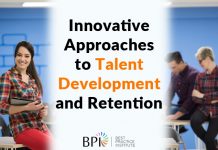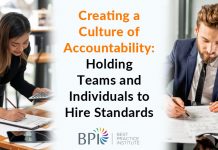Best Practices Institute’s Creating a Most Loved Workplace® research found “A most loved workplace drives productivity, from the break room to the bottom line. From the boardroom to the loading dock, when employees believe they are valued, the response is strong. They work harder to achieve personal and company goals, work more effectively within teams, and strive for success. All these are driven by respect.”
How businesses achieve this connection needs scrutiny and communication about how it works at prominent corporations like Wegmans Food Markets, Inc., Salesforce.com, and Southwest Airlines. Their common interest in articulated values, employee empowerment, and extensive learning options also shows how the Human Resource function has changed.
Best Practices at Wegmans – fully aligned business and people goals
Gates, NY is home to Wegmans Food Markets, Inc. Fortune, Bloomberg, and others regularly list it as a leader among the best-loved and most-admired companies.
Privately-held and managed by CEO Danny Wegman and President Coleen Wegman, the company has been in family hands for 100 years.
As of November 2016, Wegmans reports revenues of $7.9-billion through 92 locations with 47,000-plus employees.
Distinguished by its customer loyalty and customer service, you can infer that its employees are happily employed. Wegmans’ Media Relations Director Jo Natale told Fortune, “We empower our people to make decisions that improve their work and benefit our customers and our company.”
Wegmans has consistently won awards and recognition from the likes of Fortune, Working Mother, American Society of Training and Development, Supermarket News, Dale Carnegie Training, Ethisphere Institute, National Down Syndrome Congress, National Council on Aging, and Forbes. All the awards argue for the employee-centric organization Wegmans puts forward in its public relations, recruiting, and employee development.
Values
Wegmans’ published values determine their culture and organizational behavior. The values assume an effective connection between employee and customer. In their words (with added emphasis in bold italics):
- We care about the well-being and success of every person.
- High standards are a way of life. We pursue excellence in everything we do.
- We make a difference in every community we serve.
- We respect and listen to our people.
- We empower our people to make decisions that improve their work and benefit our customers and our company.
The people emphasis is clear, repeated, and emphatic. The very rhetoric makes the people priority a cause and an effect connection.
Beliefs
Wegmans reiterates this focus in their statement of corporate beliefs (emphasis added):
- At Wegmans, we believe that good people, working toward a common goal, can accomplish anything they set out to do.
- In this spirit, we set our goal to be the very best at serving the needs of our customers. Every action we take should be made with this in mind.
- We also believe that we can achieve our goal only if we fulfill the needs of our own people.
And, you might notice all the wording avoids reference to “employer” and “employee.”
Benefits
Wegmans chose to align benefits with goals and beliefs. For example, when it comes to medical benefits, Wegmans says, “When our people are healthy, Wegmans can work towards a common goal and can fully live our values.” They help employees stay healthy with proactive wellness and fitness programs.
In addition to the comprehensive health plans offered to all employees, they sponsor programs for childcare, eldercare, financial planning, adoption assistance, and dependent care savings accounts.
Learning environment
Wegmans President Colleen Wegman, 2012 Northeast Executive of the Year, says, “Learning and growing at Wegmans means that you’re given the opportunity to improve every day. No matter what part of the company you work in, it is important to us that everyone is engaged in our business, supports what we do, and continues to learn and grow.”
Wegmans starts new hires at payrates equal to or higher than the competitors. And, they enable learning and career growth including a competitive scholarship program providing $4.5-million in tuition assistance every year. Since 1984, they have awarded $105-million in tuition scholarships to the benefit of 33,000 employees.
Again, the commitment is always stage front with Wegmans in all their literature, employee communications, and compensation structure, including semi-annual raises.
- Promote from within through internal job postings.
- Encourage employee referrals. (1 out of 5 employees are related.)
- Provide extensive in-house training and development courses.
-
- Management Trainee Program
- Store Operations Intern Program
- Culinary Management Trainee Program
- Culinary Extern/Intern Program
- Dedicate mentors develop others by sharing knowledge, skills, and experiences.
Over half of the store managers started work at Wegmans in high school or college, completing their education thanks to the scholarship program.
Outcomes
Employees consistently rate Wegmans highly in many areas:
- 97% believe Wegmans offers great challenges.
- 97% are proud to work there.
- 96% say it has a great atmosphere with great bosses.
- 95% appreciate what the company does for the community.
- 94% say it’s a great place to work.
- 93% believe Wegmans has great ethical values and practices.
But, it takes marked leadership to get the business into this enviable position. Best Practices Institute’s study on Creating a Most Loved Workplace® found “the most basic, most desired commodity a company can offer its employees [is]: respect.”
- Empowerment: Senior managers visit each store three times a year, the SVP of Operations hosts a Q&A blog, and local managers run Huddles, Open Doors Days, and Focus Groups. Each program is a chance to listen to the people closest to the work and to the customer to facilitate continuous improvement.
- Employee Development: Wegmans invests $50+ million each year to provide training and development opportunities in the form of department universities, online courses, workshops, on-the-job experiences, cooking technique certifications, and more. They offer internships, management trainee opportunities, and leadership development.
- Talent: Wegmans recruits talent to its corporate values. Applicants must demonstrate passion for food, customers, and working with others. Hiring interview questions seek people who are caring, have high standards, make a difference, and value respect and empowerment. They also pursue diversity because it’s the right thing to do and because different perspectives give them a competitive advantage.
Conclusion
Given the consistency and continuity of its reputation, Wegmans has successfully aligned its talent management with its goals. It has made employee goals synonymous with customer goals. According to The World’s 30 Most Innovative Corporate Human Resources Departments, “What sets Wegmans apart in the HR sector is the emphasis it puts on taking care of both its employees and customers.”
Best Practices at Salesforce – the spirit of “ohana”
Salesforce is the nation’s #1 Customer Resource Management solution, market valued at $49.01 billion (01/03/2017). Forbes listed it among Most Innovative Companies 8 years in a row; Fortune placed it among Best Companies to Work For 8 years in a row; LinkedIn named it among Where the World Wants to Work Now; and, Glassdoor listed it among their Best Places to Work.
Values
Salesforce is a highly-valued company on the stock market with an irregular financial performance, but despite stock market volatility, employee turnover remains very low.
- Comradery: Salesforce is more than a people business. They look for people who enjoy working together. Chief Operating Officer, George Hu is moved by the number of people who have continued with the company for 10 years or more, “to see how we much we’ve all grown up in the company and evolved.”
- Transparency: People feel they can work hard at Salesforce, get something done along with smart and accountable peers, and have a good time doing it. EVP Jim Cavalieri feels, “Everyone that has been here for any length of time has been part of contributing to the success of the company, and we’re all on the same train.”
- Compassion: Salesforce employees give back to communities through its unique 1:1:1 Model. With assertive input from employees, Salesforce donates 1% of employee hours, 1% of its equity, and 1% of its product to causes outside their walls.
Learning environment
- V2MOM: Salesforce Chairman and CEO Marc Benioff brought the V2MOM tool with him from Oracle. He collaborated with Salesforce leaders to write a statement of Vision, Values, Methods, Obstacles, and Measures. At Salesforce, every person, process, and performance must align with the corporate V2MOM. More importantly, each employee must prepare an individual V2MOM to drive and link objectives and accountabilities.
- Chatter Polls: Short targeted surveys provide real-time feedback to leadership for its fast response. Open and transparent, such tools invite employees to speak out on community forums, to “chatter” on what they find is working and not working.
- Talent Development: #dreamjob navigator is their internal portal full of resources, including links to training courses and programs, job shadowing, and mentorship programs. Meant to afford opportunities to grow and develop, access and programs foster peer cooperation and interdependence. According to Salesforce’s Consortium for Service Innovation™, “About 13,000+ employees utilize #dreamjob central daily, using about 900 articles, of which 65% were published just-in-time.”
- Equality: Benioff avows, “Our higher purpose is to drive the Age of Equality.” Putting structure and money where their mouth is, Salesforce has operating communities labeled: Abilityforce (Disabled), Boldforce (Black), Earthforce (Environmental), Latinoforce, Outforce (LGBT), Pacificforce, SouthAsiaforce, Vetforce, and Women’s Network.
Interestingly, these diverse interests integrate vision, values, and solutions among the 19,000+ employees as well as the employees across the globe, many working in native cultures where such issues represent new exposure.
Outcomes
Their own employee survey supports the management aim of creating a sense of “ohana.” A loose translation of the Hawaiian is “family,” but the word can refer to any group or community that emphasizes no one is left behind, that members are bound and obliged to each other.
- 96% feel good about contributions to the community.
- 94% are proud of the willingness to get things done.
- 92% agree that people get along with each other.
- 96% are proud to work at Salesforce.
Conclusion
Salesforce seeks to create a sustaining culture of ohana inside and outside its operating universe. The community creates a spirit of competitive camaraderie that drives training and development, not so much from self-interest as from family potential.
Best Practices at Southwest Airlines – building employer brand
Regularly listed among the world’s most profitable airlines, Southwest Airlines’ 53,000 employees serve 100-million customers annually. A publicly-traded company, it reported $2.2 billion in net income (2015).
Fortune listed them #7 among Most Admired Companies (2015), Forbes put them at #18 among Best Employers (2015), and Glassdoor gave them the Employees’ Choice Award.
Values
Living the Southwest Way means having, in their words, “a Warrior Spirit, a Servant’s Heart, and Fun-LUVing Attitude” towards assuring a safe, profitable, and fun place to work.
- Warrior Spirit: Employees must demonstrate a desire to be the best. Southwest wants them to display urgency, perseverance, and innovation.
- Servant’s Heart: Fundamentally, Southwest wants leadership and employees to follow The Golden Rule. That means treating others with respect, putting them first, and proactively demonstrating customer service to inside and outside customers.
- Fun-LUVing Attitude: Southwest encourages employees to have fun while maintaining their perspective. As passionate team players, they can celebrate successes and enjoy the work.
These motives have served to make Southwest employees a central key to their corporate branding.
Benefits
In addition to the usual group benefits, Southwest provides:
- Financial security in 401(k), profit-sharing, and stock purchase plans.
- Health benefits plus eldercare, adoption assistance, and mental health/dependency assistance.
- Free flights, discounted flights, and guest passes.
And, they list the right to create and innovate and the ability to make a difference as “employee benefits.”
Learning environment
- Safety and Security Training: In 2015, employees spent 800,000 hours in Safety and Security training to prevent injury. Employees populate a Culture of Safety to empower and accelerate hazard reporting and mitigation.
- Kelleher Leadership: Configured by Herb Kelleher, Southwest’s legendary founder, the organization invites every employee to assess the situation before them and act on their own, so anyone can make leadership decisions if they have experienced the pertinent situation. To reinforce this, Southwest pays frontline employee positions better than those working for other airlines, but the executive titles are not.
- Kick Tails: Southwest employees get recognition in real time from local management all the way up to the CEO, and customers are invited to do the same for associates on the ground or in the air. This earns them SWAG points they can redeem for travel, gifts, and guest passes.
- Southwest Airlines University (SWA U): The training facility offers technical training and professional development. Employees and Business Partners learn in realistic situations and practice on-the-job skills.
- Diversity Council: Southwest turns a cross-departmental and cross-functional team of employees into evangelists and change agents. The Council focuses on expanding its reach and impact on respect among members of the frontline.
- Days in The Field: Associates may rotate through a department that interests them to help define their career paths.
Outcomes
Southwest has been named #1 in customer satisfaction by the US Department of Transportation; #2 on Consumer Reports’ Airline Customer Satisfaction Survey; J.D. Power’s #2 among low-cost airlines; and #2 Business Insider’s list of the best airlines in the US.
- 71% say their work is a calling.
- 97% interviewed by Glassdoor admire CEO.
- 85% would recommend employment to a friend.
Conclusion
Southwest is a dynamic and complex organization with multiple functions at multiple locations including human and capital assets in flight almost 24/7. And, they do this while heavily unionized.
They want to be “the world’s most loved, most flown, and most profitable airline.” And, they aim “to connect people with what’s important in their lives through friendly, reliable, and low-cost air travel.”
Human Resources Reconfigured
These companies were selected as employers-of-choice in widely differing industrial sectors. The outcomes testify to their value in terms of employee opinion, productivity, and customer perception. But, they also appear to have distinctly different approaches to Human Resources.
Of these three successful companies, only Wegmans shows the traditional role of Human Resources, perhaps because of the nature of its widely-scattered retail locations, historic problems that lie in retail personnel management, and the relatively high demands of their corporate culture.
Kevin Stickles is Senior Vice President of HR since October 2016. He is responsible for HR in corporate, distribution, and manufacturing employee relations, talent management, and organizational planning and design. He is also must ensure HR programs, processes, and systems support cultural and company priorities. To manage this menu of accountabilities, Wegmans has shifted some of the office’s delivery system to regional HR managers and store managers.
Salesforce shifts that paradigm with an Executive Vice President of Global Employee Success, Cindy Robbins who is tasked with leading efforts to attract, develop, and retain the best talent. Given the volume of applicants interested in employment at Salesforce, hers is a highly-prized talent. But, it appears to leave traditional HR administrative roles to other offices.
And, Southwest has a Vice President of People in Julie Weber. Ms. Weber creates and oversees activities to bring the right people to the airline, give all employees the opportunity for personal and professional growth, and assure the quality and depth of leadership throughout the company. Given the size and placement of the Southwest workforce, the emphasis it places on empowerment and fun, and its union obligations, they have clearly chosen to focus on the side of people potential.
This research indicates that there is no right Human Resources structure. Even where business succeeds with its people and its market, the nature of the business has a strong influence on its organizational structure. But, all these pulls are driving Human Resources to an accountably strategic role.










